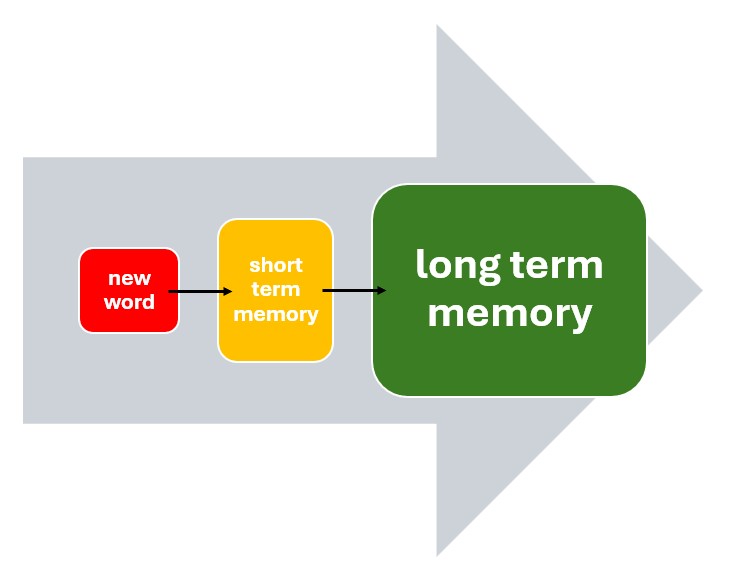Memorizing Vocabulary is Central to Language Learning
If you’re learning a new language, you know how central memorizing vocabulary is. No matter what your level is – absolute beginner or very advanced learner – memorizing vocabulary will be a major part of your language learning journey. The process in its simplest form is something like this:

When you learn new vocabulary in a foreign language, the first thing you do is get it into your short-term memory. But to truly “know” a word – to be able to retrieve it and use it later when you need it – you want to get that word into your long-term memory. In this post, we’re going to give you some tips on how to do just that. First, we’ll talk about the difference between short-term and long-term memory. Next we’ll look at a few techniques you can use to get the new vocabulary into your short-term memory. After that we’ll talk about a few techniques you can use to move the word into your long-term memory. Finally, we’ll see a few ways you can keep that word in your short-term memory.
Short-Term Memory vs. Long-Term Memory
Humans have two different kinds of memory, short-term memory and long-term memory. They differ primarily in how long the retention lasts, and what we use the retained information for. With short-term memory, information is retained for a short period, from a few seconds to a few minutes. We use our short-term memory to complete an immediate task, for example to remember which gate our flight departs from. Information stored in short-term memory fades after it’s needed. For example, unless you’re sitting in a departure lounge at an airport, you probably can’t recall the gate that your last flight departed from.
With long-term memory, information is retained for much longer, from days to years, or even over the course of a lifetime. We use our long-term memory for information that we need for something greater than a quick, immediate task. Think of examples like your social security number, your childhood address or phone number, the names of your relatives, and so on.
Short-Term Memorization Techniques
Information gets into our short-term memory typically through cramming or a burst of quick repetition. When you’re learning a language, you’re constantly encountering new vocabulary. To get it into your short-term memory, you might take advantage of any of these cramming-repetition techniques:
- Spoken repetition: Say the word aloud to yourself several times.
- Written repetition: Write the word several times, and speak it aloud each time your write it.
- Vocabulary practice exercises: Any structured language learning program, whether it’s a class, an app, or a book, will have some version of this. These exercises could be matching games, fill-in-the-blank, multiple choice, spoken practice, translation, and so on.
- Flashcards: Create a deck of ten or twenty vocabulary words, either physically on paper or with an app, and practice going through the deck. First, from the target language into your source or native language, and then in the other direction.
These techniques, or similar ones that you may use, will get new vocabulary into your short-term memory. The information will stick long enough for you to do the immediate task at hand – play some game on your app, pass a test, or finish a reading in a language course. But, this isn’t the whole story, and even if you ace that test, you may not have really learned the vocabulary. To do that, you need to get it into your long-term memory. That’s where it will stay so that you can access it weeks, months, or years later.
Long-Term Memorization Techniques
The keys to moving vocabulary from your short-term memory to your long-term memory are repeated exposure, practice and regular engagement, and spaced (rather than crammed) repetition. The great thing about long-term memorization techniques is that you can really personalize them to fit your interests. And once something is in your long-term memory, it’s much more stable and harder to forget that items in your short-term memory. Let’s look at a few concepts and techniques that you can use when memorizing vocabulary to get things into your long-term memory.
1. Thematic Grouping
Grouping vocabulary by theme or topic can make learning more manageable and meaningful. Instead of learning random words in isolation, focus on related words that you might use together in a conversation. For example, if you’re memorizing vocabulary related to food, study words for different types of food, cooking methods, and phrases you’d use at a restaurant. Thematic learning allows you to create mental connections between words, making it easier to recall them when needed. These connections are essential in the architecture of memory in general, so it’s no surprise that they’re important when memorizing vocabulary in a new language.
2. Create a Vocabulary Journal
It’s easier for most people to remember things when they write them down. Obviously this creates a record that you can go back to and review whenever you want. But the action of writing (and speaking while you do it) is a great tool for starting the process of memorizing vocabulary. Keep your journal in whatever form you’d like, for instance a note on your phone, a doc stored on your laptop or in the cloud, or a physical notebook. Just make sure it’s easily accessible, because you’ll want to come back to it and review on a regular basis. Incorporate thematic groupings in your journal as discussed above.
3. Spaced Repetition Systems (SRS)
Spaced repetition is a scientifically proven method for learning and retaining information, including vocabulary. This kind of repetition means exposure to new information at increasing intervals. Thankfully, there are plenty of SRS tools available to make this easy for you. Apps like Anki, Memrise, or Quizlet are popular among language learners because they optimize the timing of your reviews. These tools present words at increasing intervals, which ensures that you review them just before you’re likely to forget them. By regularly practicing with an SRS, you can efficiently build a solid vocabulary base and move new vocabulary inot your long-term memory.
4. Active Usage
Active usage of new vocabulary is crucial for transferring words from passive recognition to active recall. Make it a habit to use new words in sentences, either through speaking or writing. For example, you can write short stories, simple journal entries, or social media posts in your target language. Carve out a regular schedule of a few minutes a day to do this, for example jot down a journal entry at the end of each day. You should also engage in conversations with language partners or tutors. During these sessions, challenge yourself to incorporate new vocabulary into your speech. By actively using the words, you’ll strengthen your ability to recall and use them in the future.
5. Immerse Yourself in Your New Language
Immersion is key to natural language acquisition. Surround yourself with the language as much as possible through various forms of media such as movies, videos on topics you find interesting, TV shows, music, podcasts, and books. When you encounter new words, take note of them in context. Seeing and hearing vocabulary used in real-life situations helps reinforce meaning and usage. This type of immersion is much easier in today’s digital age than it used to be! Nowadays, if you have a streaming service or internet access, you’ve got a huge library of immersive contact at your finger tips. But if you want to try something more old school to memorize vocabulary, you can label objects in your environment with sticky notes in the target language. This creates a constant learning environment that can reinforce your vocabulary through daily exposure.
6. Engage in Repetitive, Multi-Sensory Activities
Repetition is key to memory, and engaging in multi-sensory activities can enhance the learning process. Combine visual (seeing), auditory (hearing), and kinesthetic (doing) learning styles by writing words down, saying them aloud, and associating them with images or actions. For instance, you can create flashcards with pictures, listen to audio recordings while writing the words, or even perform actions that represent the words. The more senses you involve in the learning process, the stronger the memory associations you’ll create.
Conclusion
Memorizing vocabulary in a foreign language is an ongoing process that requires dedication, creativity, and consistent practice. By grouping vocabulary by theme, keeping a vocabulary journal, using spaced repetition systems, actively using new words, immersing yourself in the language, and engaging in multi-sensory activities, you can significantly enhance your ability to learn and retain vocabulary. Remember, patience and persistence are key—every word you learn brings you one step closer to fluency. And as always – customize the process to meet your interests, your learning style, and your schedule.






